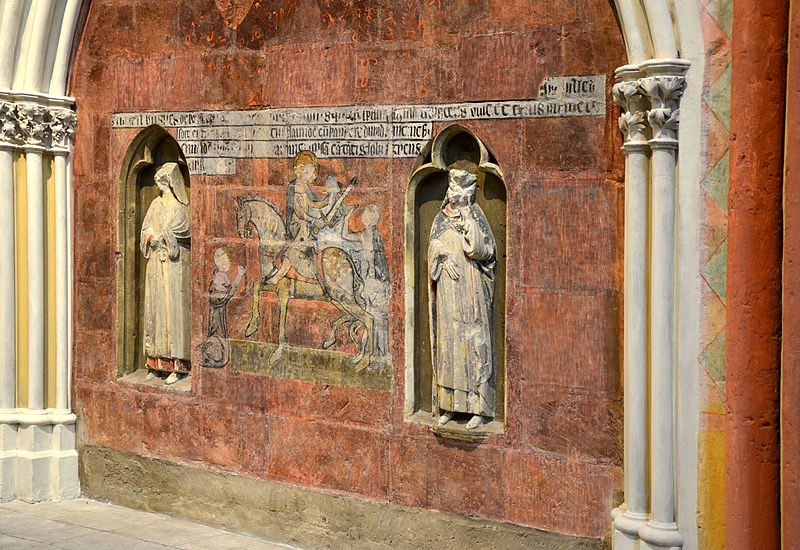Dans la cathédrale Saint-Gatien de Tours, cette peinture murale date du XIVe siècle, elle provient d’un tombeau disparu. Elle représente une scène classique de la charité : un élément d’originalité réside dans la présence devant le cheval du saint, d’un moine en prières , rappelant l’élan monastique lié à saint Martin et la place occupée par les frères mendiants dans la diffusion des pratiques charitables dans la chrétienté médiévale. Les couleurs lumineuses se détachent sur le fond ocre et permettent de voir la scène du partage comme réalisée puisque le manteau recouvre les épaules du pauvre, debout tenant fermement le coin de l’étoffe.
La peinture se trouve dans la chapelle Sud du déambulatoire , derrière le tombeau des enfants de France ; les dauphins Charles-Orland ( 1492-1495) et Charles (+1496), fils d’Anne de Bretagne et Charles VIII sont enterrés ici. Le tombeau fut réalisé de 1499 à 1506 d’une part, par un sculpteur italien pour la cuve (Girolamo Paciarotto, dit Jérôme Pacherot), et d’autre part, par l’atelier du sculpteur tourangeau Michel Colombe pour les deux petits gisants.
In the cathedral of Saint-Gatien in Tours, this mural painting dates from the 14th century and comes from a tomb that has disappeared. It represents a classic scene of charity: an original element lies in the presence of a monk in prayer in front of the saint’s horse, recalling the monastic impulse linked to Saint Martin and the place occupied by the mendicant brothers in the diffusion of charitable practices in medieval Christianity. The luminous colours stand out against the ochre background and allow the scene of sharing to be seen as having been carried out, since the cloak covers the shoulders of the poor man, who is standing holding the corner of the cloth firmly.
The painting is in the south chapel of the ambulatory, behind the tomb of the children of France; the dauphins Charles-Orland (1492-1495) and Charles (+1496), the sons of Anne of Brittany and Charles VIII, are buried here. The tomb was made between 1499 and 1506 by an Italian sculptor for the vat (Girolamo Paciarotto, known as Jérôme Pacherot), and by the workshop of the Touraine sculptor Michel Colombe for the two small recumbents.

 "/>
"/>